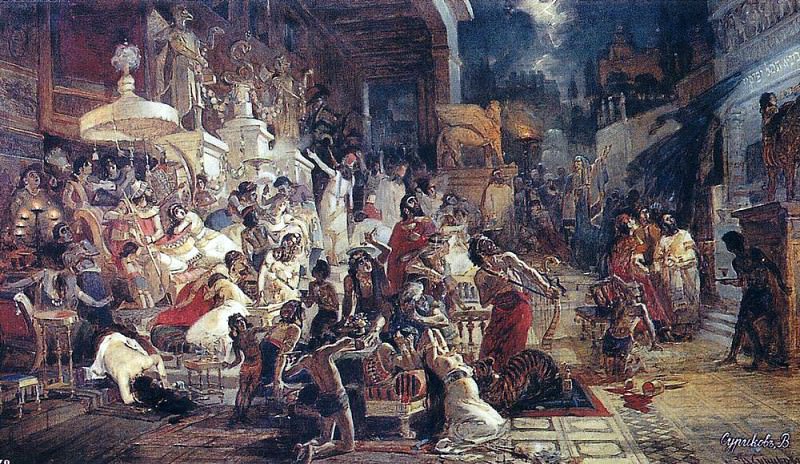Feast of Belshazzar Vasily Ivanovich Surikov (1848-1916)
Vasily Ivanovich Surikov – Feast of Belshazzar
Edit attribution
Download full size: 1000×579 px (0,3 Mb)
Painter: Vasily Ivanovich Surikov
Vasily Surikov was born in Krasnoyarsk in 1848 to a family of hereditary Don Cossacks who came with Yermak back in the sixteenth century during the conquest of Siberia. His talent for painting manifested itself quite early, but because of the early death of his father, the family had no money for a decent education. Only luck helped Surikov when Governor Zamyatin of Yenisey saw his drawings, found the patron of the arts I.P.
Description of Vasily Surikov’s painting "The Feast of Belshazzar".
Vasily Surikov was born in Krasnoyarsk in 1848 to a family of hereditary Don Cossacks who came with Yermak back in the sixteenth century during the conquest of Siberia. His talent for painting manifested itself quite early, but because of the early death of his father, the family had no money for a decent education. Only luck helped Surikov when Governor Zamyatin of Yenisey saw his drawings, found the patron of the arts I.P. Kuznetsov, who paid for his education at the Academy, and at the age of 21, Vasily Surikov became a student in St. Petersburg.
His monumental paintings, thanks to which Surikov gained fame and renown, are executed with a profound compositional, color and plastic approach. Most of the paintings - "The Morning of Streletsky Execution", "Suvorov’s Crossing of the Alps", "Conquest of Siberia by Yermak" - are filled with many different characters, each of them elaborated with their own character, moment of emotions, with a careful choice of colors. Although many of his contemporaries often criticized Surikov for this "mishmash" of faces and bodies and compared his paintings to a "brocade carpet," this became a distinctive feature of his paintings, his special energy and a valuable historical and artistic asset of Russian culture.
The painting The Feast of Belshazzar is also executed in the artist’s favorite manner - the culmination of a significant event in history. Belshazzar, having inherited the reign of Babylon after his father’s death, holds a grand feast at which a huge number of guests, servants, concubines, priests and slaves are drowned in wine and vice. When the guests ran short of dishes, Belshazzar ordered the golden ritual cups looted during the destruction of the Temple in Jerusalem to be brought in.
But as soon as the new lord of the world touched the goblet, the sky trembled with angry peals of thunder, lightning illuminated the unruly crowd, and a luminous encrypted inscription appeared on the wall. Anticipating trouble, Belshazzar seeks someone who can read the fateful message, and the prophet Daniel is brought to him. The painting depicts the moment when Daniel translates to the king a mysterious inscription that foretells the imminent destruction of the desecrator of the holy places, pointing to the burning signs, while numerous ... guests and servants are writhing around Belshazzar, distraught and panic-stricken.
The rich brightly colored expensive garments, ornamented with jewels, gold tableware, lamps, furniture - how pathetic they look under the fire of divine wrath. The red cloaks, the red carpets, the red wine spilled in the foreground - all this seems to be a harbinger of bloodshed soon, because the celebrating king had no time to protect the city, whose walls were reached by the Persian troops. The Babylonian priests are still stretching out their hands to the pagan idols and pleading for protection, but the outcome of the grand and tragic feast is quite clear - the desecrators cannot escape heaven’s punishment.
Кому понравилось
Пожалуйста, подождите
На эту операцию может потребоваться несколько секунд.
Информация появится в новом окне,
если открытие новых окон не запрещено в настройках вашего браузера.
You need to login
Для работы с коллекциями – пожалуйста, войдите в аккаунт (open in new window).




















COMMENTS: 2 Ответы
Блин а где описание та???!
в интернете
You cannot comment Why?
The painting depicts the biblical story of Belshazzars Feast, as described in the Book of Daniel. In the scene, the Babylonian king Belshazzar and his courtiers are in the midst of a lavish banquet, using sacred vessels looted from the Temple in Jerusalem. Suddenly, a disembodied hand appears and writes a message on the wall, foretelling the downfall of the kingdom.
Heres a breakdown of what can be observed and interpreted:
What I See:
Subtexts:
In essence, the painting Feast of Belshazzar is a dramatic depiction of a pivotal moment where divine judgment abruptly interrupts human revelry, serving as a timeless moral lesson on piety, humility, and the consequences of defying sacred order.